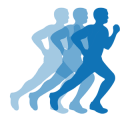Patellofemoral Pain Syndrome (PFPS), also recognized as Runner’s Knee, Chondromalacia Patellae, Anterior Knee Pain, or Patellofemoral Joint Syndrome, is a condition caused by the kneecap’s friction against the underlying femur bone.
Medically reviewed by Dr Chaminda Goonetilleke, 21st Dec. 2021
Patellofemoral pain syndrome symptoms
Symptoms of Patellofemoral Pain Syndrome typically include:
- Aching pain in the knee joint, predominantly at the front and beneath the kneecap
- Tenderness along the kneecaps inside border
- Occasional post-exercise swelling
- Exacerbated pain during uphill or downhill walking, or extended sitting
- Clicking or cracking sounds during knee bending
- Possible reduction in quadriceps muscle size, notably the vastus medialis oblique, on the affected side
Assessment tests
A trained therapist will conduct various tests to determine the cause of your pain, and exclude similar symptoms from other conditions, like a synovial plica. Measurements may include the ‘Q angle’ of your knee, which assesses the alignment of the knee joint.
Additional tests encompass:
- The Apprehension Test
- Patella Compression Test
- Patella Grind Test
What is Patellofemoral pain syndrome?
The kneecap, or patella, is anchored at the front of the knee, connecting the quadriceps muscles to the shinbone via the patellar tendon. Its role as a lever for the thigh muscles is crucial.
Patellofemoral Pain Syndrome (PFPS) ensues when the patella rubs against the femur bone beneath. Misalignment can lead to irritation and damage, potentially causing degeneration of the hyaline cartilage under the patella over time.
Who does PFPS affect?
Patellofemoral pain predominantly affects active individuals, notably adolescent girls, likely due to growth-related changes. Women, with generally wider hips and thus increased ‘Q angle’, and long-distance runners are also at an elevated risk of this knee pain.
What causes patella pain?
Patellofemoral pain syndrome often originates from overuse, either due to external factors like sudden training intensification or internal factors like poor patella tracking. Understanding the cause aids treatment.
Although cartilage damage doesn’t directly cause pain due to a lack of blood vessels or nerves, it can trigger problems that lead to pain, such as:
- Synovitis: inflammation of the joint’s synovial membrane
- Erosion of cartilage and eventual bone damage
- Soft tissue injuries, e.g., to the lateral retinaculum or patella fat pad
Various factors can heighten the risk of this condition:
External factors
Running Shoes: The right footwear is vital as incorrect running shoes can lead to poor foot biomechanics. Motion-control shoes, with firmer insoles, are optimal for overpronators. The shoe’s wear pattern and age typically replaced every 500 miles or 6 months, can also be important indicators.
Training: Enhanced training load, whether by mileage, frequency, or intensity, intensifies the strain on the patellofemoral joint. Training surfaces play a role too; hard surfaces increase the joint load compared to softer ones like grass or artificial training areas.
Intrinsic factors
Intrinsic Factors: These relate to your body’s individual characteristics:
Femur: Excessive internal rotation, signified by inward-facing patellae during activities like running or squats, points to weak hip muscles, notably the gluteus medialis.
Knee: An increased Q angle (over 18-20 degrees) indicates potential patella tracking issues. The kneecap position—rotated, tilted, or displaced—plays a part in this.
Tibia: Overpronation leads to excessive tibia rotation, affecting patella tracking due to the inward-rotating femur.
Foot Biomechanics: Overpronation, causing the foot to roll inwards and flatten excessively, results in tibial rotation.
Flexibility: Limited flexibility, particularly tight outer knee and hip muscles (tensor fascia lata and iliotibial band), can affect the knee joint.
Soft Tissue: Tight surrounding tissues like the lateral retinaculum and iliotibial band, coupled with a weak vastus medialis muscle, can be detected through patella position or palpation.
Neuromuscular Control: Proper contraction timing of the vastus medialis is vital. Muscle bulk doesn’t guarantee proper functioning. Delayed contraction compared to other quadriceps muscles may contribute to the issue and should be assessed in various positions, especially those relevant to the patient’s sports activities.
Patellofemoral pain syndrome treatment
Treatment focuses on alleviating symptoms, identifying causes, and fortifying or re-training related muscles:
Cold Therapy: Use PRICE (Protection, Rest, Ice, Compression, Elevation) post-activity to reduce pain and swelling.
Rest: Avoid aggravating activities until pain-free.
Knee Brace: Use a patella-tracking knee brace for support.
Medication: Anti-inflammatory medications like ibuprofen might be recommended by a doctor (not suitable for asthmatics).
Patella Taping: Provides instant pain relief by directing the kneecap away from the pain source, easing strengthening exercises.
Sports Massage: Helps loosen tight structures and muscles, typically on the thigh’s outside.
Gait Analysis: Determines overpronation and the need for orthotic inserts to correct poor foot biomechanics.
Surgery: For chronic cases, surgery to release the knee’s tight lateral structures may be considered, but success rates vary.
Exercises: Depending on the pain source, exercises typically target strengthening the inner thigh muscles. Heel drop exercises, for instance, fortify the vastus medialis muscle, aiding normal patella tracking. Stretching exercises for the outer knee structures, hamstrings, and calf muscles are equally crucial to prevent abnormal patella tracking.
Returning to fitness and prevention
A gradual return to full fitness is crucial, beginning sport-specific training only once pain-free. Full-strength restoration through exercise is essential for balanced muscle strength.
Taping the knee or using support during the sport resumption may be required, but long-term dependency should only be if advised by your therapist. Rectifying any biomechanical abnormalities, like pronation, is necessary to prevent injury recurrence.
